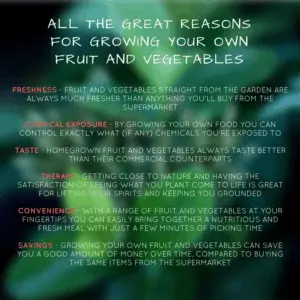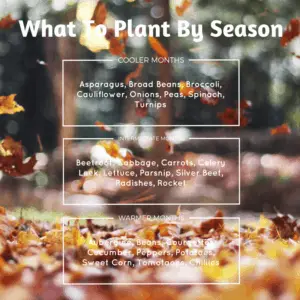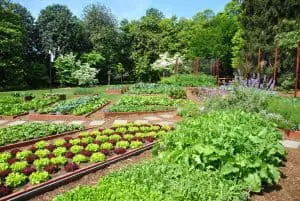Contents
Is edible gardening a new concept for you?
Have you been thinking about it, researching it and deciding whether to go ahead and create your own edible garden?
Maybe you stumbled on this site and have been reading some of the articles about how to grow and maintain your garden but you’re still wondering about some of the basics?
Well this article is for you – a beginners guide to edible gardening.

So now you know why you should give fruit and vegetable gardening a go. But what other points should you consider before you get started?
What Do You Want To Grow?
Before you start building a ton of planter boxes or buying out your local store of tubs, consider what kinds of fruit and vegetables you want to grow, and how much of it.
It’s pointless creating a whole lot of space for large crops of corn if no one in your family likes corn, or dedicating a patch of your precious space to crops like Asparagus (that prefer not to be moved), if you find that store bought Asparagus tends to sit around and never get eaten.
Write up a list of all the fruit and vegetables that you buy regularly and always eat and then consider how much of this you can grow in the space you have.
How Much Space DO You Have?
In the past only those with large, sprawling gardens and lifestyle blocks considered growing their own produce. Growing fruit and vegetables was for the serious gardener with dedicated planter boxes and custom built greenhouses.
Well all that has changed.
Now just about anybody can consider growing an edible garden of some kind, be it big or small. There are gardeners with acres of land to play with and there are balcony gardeners with plenty of delicious, fresh produce growing in pots.
No area is too small to turn into your own little slice of edible garden.
To plan out how much you can grow in the space you have, check out the Kitchen Garden Planners on Garden.com.
What Will Grow In Your Climate?
When you look at your list you created above, it’s also important to consider whether the choices you’ve made will grow easily in your climate. As a beginner you may decide to make things easy on yourself and only grow what grows easily in your area.
Or, you can create your own micro climates and not only help borderline plant options along but also extend the growing times for crops that need a longer, warmer growing period. For example we plant our Passionfruit in the corners of our greenhouse and run them along the top edges. They grow pretty well in there but still don’t fruit as prolifically as they would in warmer areas.
Growing Conditions
When it comes time to plant out your new fruit and vegetable garden, it’s important to think about where you put your gardens and trees.
You need to consider where you get the most sun during the day and what areas are shaded. Vegetable crops like tomatoes, courgettes, capsicum and cucumbers need at least 5 hours of full sun a day where as leafy green vegetables like spinach, lettuce and kale while tolerate a shadier spot.
Prevailing winds are also worth paying attention to. If your proposed vegetable garden site is exposed to strong winds you’ll need to install some kind of wind break like a hedge or fencing. Cool winds will stunt the growth of many heat loving vegetables and hot winds will cause moisture evaporation.
It’s also important to notice what existing vegetation you might be competing with. Any large trees nearby will not only take moisture and nutrients from your plants, but may also throw shade you don’t want.
What To Grow, When
Planting your vegetables at the right time is critical if you want to have the best crop success.
When it’s too hot some plants will ‘bolt’ and go straight to seed, while others will fail to thrive if it’s too cool.
Here’s a quick view of the types of vegetables to grow in each season.

Start With The Best Foundation
Whether you choose to grow in containers, planter boxes or directly in the garden, good quality soil is the most critical element to start your garden with if you want it to be healthy and productive.
If you’re using existing soil be sure to add in fresh compost and manure to help boost fertility.
If you’re planting directly in the ground you also want to make sure you sort out any issues with your soil such as high clay content or excess sand before you get started.
To find out which you have wet some dirt and press it between your fingers. If it’s sticky or slimy, it’s higher in clay. If it’s gritty and dries quickly, it’s higher in sand. Knowing which type of soil you have will help you decide how to balance it out for better growing conditions.
Seed Or Seedlings
Some beginner gardeners find the thought of growing everything from seed a little daunting. They worry that they’ll end up with nothing other than bare soil and a lot of lost time.
It doesn’t have to be that scary to get started with seed, though. If you want to improve your chances of actually getting something from what you’ve planted buy good quality seed from reputable seed suppliers and, if you really want to secure your success buy varieities that have been created for their resiliance against pests and certain environmental condition.
But if you still want to play it safe, seedlings are a great way to get going fast without the concern of seed strike rate. You will pay only a few dollars for a punnet of seedling (usually 6-12 plants) and still gain a great crop for a mere fraction of the price you’d pay in store for the vegetables you grow.
When picking your seedlings choose strong, healthy looking plants that aren’t root bound in the punnets. And be sure to plant them as soon as possible when you get home, with a good feed of fertiliser for good luck.
Crop Rotation
After your first year of growing vegetables, and before the next growing season, you want to consider some crop rotation.
Rotating crops simply means changing what crops you grow in each garden each year.
The reason you want to consider crop rotation is because if the same crops are grown in the same garden year on year, you can encounter diseases in crops and also see a depletion of important nutrients that are taken up by that crop.
So, if you planted your peas in one garden this year, plant them in another garden where you grew a dissimilar crop the next growing season. For example, you might move your Peas to where you grew your Pumpkins and move your Pumpkins to where you grew your Onions, and so on.
If you don’t have the room (or desire) for crop rotation them it is important to revitalise your soil each growing season with fresh compost and fertilisers to make sure your new crops get the best growing conditions.
Fertislisers and Sprays
When many people first start edible gardening they want the best results and will invest in all sorts of tools to help them. This can include sprays and fertilisers to improve cropping and keep away pests.
But before you sink a whole load of money into all those promises of being bug free and heaving with produce think about exactly what you’re adding into your garden and what effect that might have on the food you’re growing, and on you!
If you’re looking to grow in a chemical free environment there are a lot of natural options for keeping pests and diseases at bay. You can even use products from your garden to create natural pesticides and fertilisers, like Rhubarb Leaf Pesticide and Banana Fertiliser.
Just Do It
Now that you have some basic knowledge behind you the next step is to just give it all a go.
With gardening you’ll always experience points of trial and error but with time you’ll learn so much, gain confidence and become a great gardener if you keep going and adjust along the way.
Some things will work out well, others won’t, but by trying different things you’ll soon learn what grows best, and where and how to get bumper crops from your time and investment in your garden.
Want to know more about gardening ?
Fill in your email address in the form below and you'll receive all the latest updates directly in your in-box.
Thank you for subscribing.
Something went wrong.
